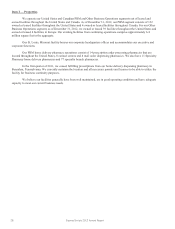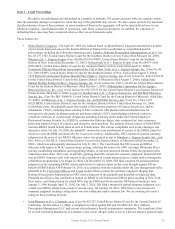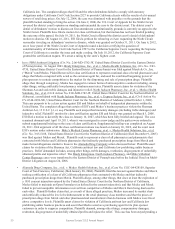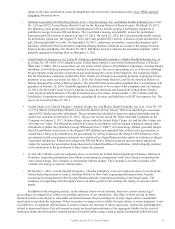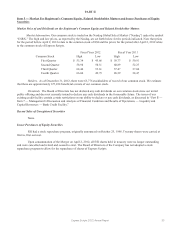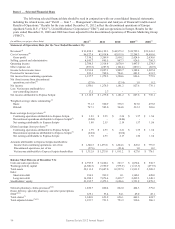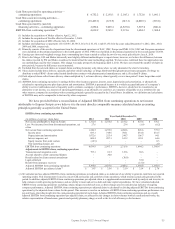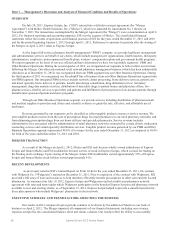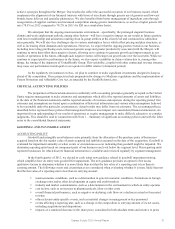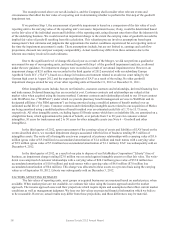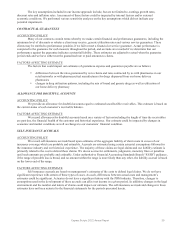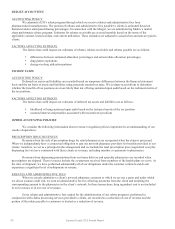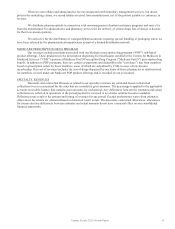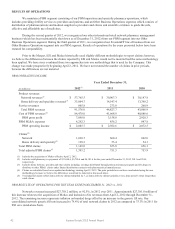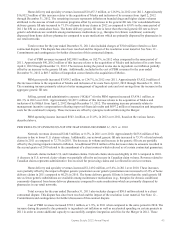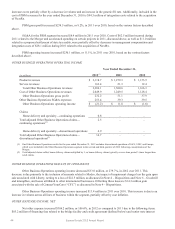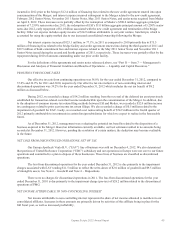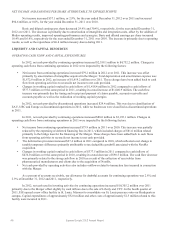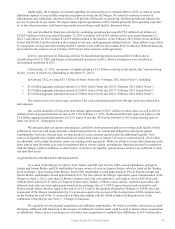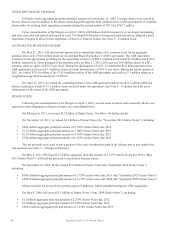Express Scripts 2012 Annual Report Download - page 40
Download and view the complete annual report
Please find page 40 of the 2012 Express Scripts annual report below. You can navigate through the pages in the report by either clicking on the pages listed below, or by using the keyword search tool below to find specific information within the annual report.
Express Scripts 2012 Annual Report38
The examples noted above are not all-inclusive, and the Company shall consider other relevant events and
circumstances that affect the fair value of a reporting unit in determining whether to perform the first step of the goodwill
impairment test.
If we perform Step 1, the measurement of possible impairment is based on a comparison of the fair value of each
reporting unit to the carrying value of the reporting unit’s net assets. Impairment losses, if any, would be determined based
on the fair value of the individual assets and liabilities of the reporting unit, using discount rates that reflect the inherent risk
of the underlying business. We would record an impairment charge to the extent the carrying value of goodwill exceeds the
implied fair value of goodwill resulting from this calculation. This valuation process involves assumptions based upon
management’s best estimates and judgments that approximate the market conditions experienced for our reporting units at
the time the impairment assessment is made. These assumptions include, but are not limited to, earnings and cash flow
projections, discount rate and peer company comparability. Actual results may differ from these estimates due to the
inherent uncertainty involved in such estimates.
Due to the significant level of change this fiscal year as a result of the Merger, we did not perform a qualitative
assessment for any of our reporting units, and instead began with Step 1 of the goodwill impairment analysis, as allowed
under the new guidance. No impairment charges were recorded as a result of our annual impairment test. However, an
impairment charge of $2.0 million was recorded in the third quarter of 2012 associated with our subsidiary Europa
Apotheek Venlo B.V. (“EAV”), based on a change in business environment related to an adverse court ruling by the
German high court in August 2012 and the expected disposal of EAV as a result of the ruling. No other goodwill
impairment charges existed for any of our other reporting units at December 31, 2012 or December 31, 2011.
Other intangible assets include, but are not limited to, customer contracts and relationships, deferred financing fees
and trade names. Deferred financing fees are recorded at cost. Customer contracts and relationships are valued at fair
market value when acquired using the income method. Customer contracts and relationships related to our 10-year contract
with WellPoint, Inc. (“WellPoint”) under which we provide pharmacy benefit management services to WellPoint and its
designated affiliates (“the PBM agreement”) are being amortized using a modified pattern of benefit method over an
estimated useful life of 15 years. Customer contracts and relationships intangible assets related to our acquisition of Medco
are being amortized using a modified pattern of benefit method over an estimated useful life of 1.75 to 15.75 years,
respectively. All other intangible assets, excluding legacy ESI trade names which have an indefinite life, are amortized on a
straight-line basis, which approximates the pattern of benefit, over periods from 5 to 20 years for customer-related
intangibles, 10 years for trade names and 2 to 30 years for other intangible assets (see Note 6 – Goodwill and other
intangibles).
In the third quarter of 2012, upon reassessment of the carrying values of assets and liabilities of EAV based on the
events described above, we recorded impairment charges associated with this line of business totaling $9.5 million of
intangibles assets. The write-off of intangible assets was comprised of customer relationships with a carrying value of $3.6
million (gross value of $5.0 million less accumulated amortization of $1.4 million) and trade names with a carrying value
of $5.9 million (gross value of $7.0 million less accumulated amortization of $1.1 million). EAV was subsequently sold on
December 4, 2012.
In the third quarter of 2012, as a result of our plan to dispose of our PolyMedica Corporation (“Liberty”) line of
business, an impairment charge totaling $23.0 million was recorded against intangible assets to reflect fair value. The write-
down was comprised of customer relationships with a carrying value of $24.2 million (gross value of $35.0 million less
accumulated amortization of $10.8 million) and trade names with a carrying value of $6.6 million ($7.0 million less
accumulated amortization of $0.4 million). This charge was allocated to these assets on a pro rata basis using the carrying
values as of September 30, 2012. Liberty was subsequently sold on December 3, 2012.
FACTORS AFFECTING ESTIMATE
The fair values of reporting units, asset groups or acquired businesses are measured based on market prices, when
available. When market prices are not available, we estimate fair value using the income approach and/or the market
approach. The income approach uses cash flow projections which require inputs and assumptions that reflect current market
conditions as well as management judgment. We base our fair values on projected financial information which we believe
to be reasonable. However, actual results may differ from those projections, and those differences may be material.


